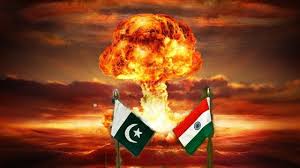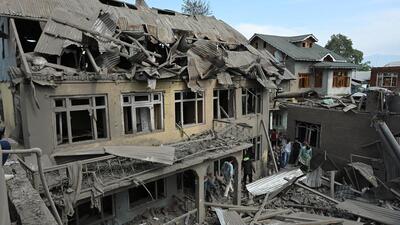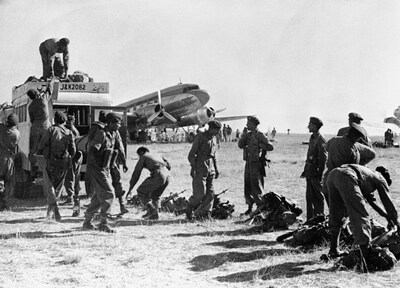Osman Softić ||5 May 2025
 The terrorist attack which took place on April 22, 2025 in the Baisaran valley near Pahalgam, a serene mountain resort in the Indian controlled Jammu and Kashmir took the lives of 26 innocent tourists from various parts of India while injuring around twenty others. This savage mass murder of civilians shocked the entire world as well as the Muslim majority population of Kashmir and indeed the people across India. It appears that this was a meticulously planned and precisely targeted killing of Indian citizens of the Hindu faith, seemingly executed by professionally trained perpetrators.
The terrorist attack which took place on April 22, 2025 in the Baisaran valley near Pahalgam, a serene mountain resort in the Indian controlled Jammu and Kashmir took the lives of 26 innocent tourists from various parts of India while injuring around twenty others. This savage mass murder of civilians shocked the entire world as well as the Muslim majority population of Kashmir and indeed the people across India. It appears that this was a meticulously planned and precisely targeted killing of Indian citizens of the Hindu faith, seemingly executed by professionally trained perpetrators.
The attack has particularly alarmed and intimidated Muslims in India who fear potential retaliatory repercussions, which could lead to the anger of the Hindu majority being unleashed on innocent Muslims across India. The Kashmir dispute is as old as the Palestinian question and encompasses various dimensions. It could be analyzed from different perspectives. A real danger of uncontrolled vengeance against Muslims in India is heightened by the already entrenched intercommunal tensions fueled by the ultranationalist ruling Hindu Bharatiya Janata Party (BJP) which derives its political, religious and nationalist legitimacy, at least in part, from the ideology of Hindutva (Hindu religious ultranationalism), which has been propagated over decades by the Rashtriya Swayamsevak Sangh (RSS), National Volunteer Corps, Hindu-based mass paramilitary organization.
The RSS – Rashtriya Swayamsevak Sangh
RSS, apart from Hinduism, draws its inspiration from the organizational principles and discipline of the Italian fascism of the bygone era. The ultimate goal of the RSS is to transform India from a secular, tolerant, multiethnic and multireligious republic into a Hindu state (Hindu Rashtra) based on the dominance of an extreme form of Hinduism, in opposition to India’s secular constitution grounded in pluralism and democratic principles.
The RSS serves as the primary ideological incubator that has produced a significant number of political cadres for the ruling party. It enjoys financial support from wealthy business elites and some of India’s largest capitalist oligarchs. BJP builds its political legitimacy by mobilizing Hindu population across India while targeting marginalized Muslim and Christian minority populations and by stoking interfaith tensions. Certain actions by the Indian government, such as the Citizenship law or the usurpation of Muslim religious sites, are evidence of discrimination and, at times, open lynching of Muslims.
Out of total 90 seats in the Jammu & Kashmir assembly, National Conference (NC), mainstream Muslim majority party, the oldest Muslim political organization in Kashmir led by Farooq Abdullah (a proven pro-Indian politician), holds 42 seats, while BJP holds 29 as the second most powerful political force in Jammu and Kashmir. Other parties have only marginal influence with a small number of seats. Farooq’s son, Omar Abdullah, has been appointed as Chief minister and has presided over the Council of Ministers since October 2024, when elections were allowed to be held. However, the real power in Kashmir, following the revocation of Article 370 of the Indian Constitution in 2019, lies with the central government in New Delhi, represented in Kashmir by Sh. Manoj Sinha, a lieutenant governor appointed by the president of India on the recommendation of the Prime Minister.
In 2019 Jammu and Kashmir was stripped of its autonomous state status and downgraded to a union territory. Additionally, the other administrative region of Kashmir, Ladakh, was separated from Kashmir by the same decision of the Indian parliament and granted equal status as a new union territory (a significant concession to the majority Buddhist population of Ladakh). The majority population in Ladakh is Buddhist, with the second-largest religious group being Muslims, predominantly of the Twelver Shia legal school in Islam. In the southern administrative unit of Jammu, the majority of residents are Hindus, including the displaced Kashmiri Pandits who have lived alongside Muslims for centuries. Pandits are Hindu minority in the Muslim-majority Kashmir, some of whom belonged to the Hindu elite that was not Islamized during centuries of Muslim rule in Kashmir. Pandits fled Kashmir during the major unrest in the Kashmir Valley in the 1990s due to clashes between Islamic militants (Kashmiri separatists) and security forces loyal to India. Some of India’s most prominent figures, such as Jawaharlal Nehru, the leader of India’s anti-colonial independence movement, were Kashmiri Pandits.
Secular and liberal critics of the political and religious ideology of Hindu fundamentalism often describe this recent phenomenon as a “pakistanization” of secular India, given that Pakistan bases its political and state legitimacy on the distinction between Muslims and Hindus, or on a distinct Muslim identity, as articulated in the “two-nation theory” proclaimed by the father of the Pakistani nation and state, Muhammad Ali Jinnah. The ruling BJP deliberately promotes religious segregation in India because it has a strong electoral Hindu base. Unlike the Indian opposition led by the more moderate and secularly oriented Indian National Congress, BJP does not rely on Muslim votes to win power, and therefore seeks to marginalize and alienate them. By fostering intercommunal tensions BJP uses its antagonistic stance toward Muslims as a convenient strategy for Hindu mobilization. The BJP government’s policy is based on relegating India’s Muslim minority (200 million people) to second-class citizens, accusing them of being descendants of the former Muslim occupiers of India.
The Pahalgam attack
 The attack in Pahalgam has once again pushed the two neighboring states, which have maintained hostile relations for eight decades, to the brink of a potential new armed conflict. It is noteworthy that the latest terror attack in Kashmir is significantly different from previous attacks, which were primarily directed at members of the Indian army and police or civilians living in Kashmir who were deemed to be directly involved in the repressive system. Victims hence included state officials, judges, journalists and even Muslims viewed as loyal to the central and oppressive government in New Delhi.
The attack in Pahalgam has once again pushed the two neighboring states, which have maintained hostile relations for eight decades, to the brink of a potential new armed conflict. It is noteworthy that the latest terror attack in Kashmir is significantly different from previous attacks, which were primarily directed at members of the Indian army and police or civilians living in Kashmir who were deemed to be directly involved in the repressive system. Victims hence included state officials, judges, journalists and even Muslims viewed as loyal to the central and oppressive government in New Delhi.
Moreover, earlier terrorist attacks were often deliberately suicidal, whereas the latest attack was carried out with a successful exfiltration, meaning the perpetrators have not yet been completely identified, killed, or apprehended, but simply vanished after the attack. This suggests a carefully planned and professionally executed operation with the characteristics of a military action by specially trained commandos.
The oldest and potentially most dangerous frozen armed conflict in the world, which could have catastrophic consequences, is undoubtedly the unresolved dispute between the two nuclear powers, India and Pakistan, over the contested territory of Kashmir, which spans parts of Pakistan, India, and China (Aksai Chin). These states on the “rooftop of the world,” as described by Eric Margolis, investigative journalist, businessman, and philanthropist, are once again on the brink of a new war. If it escalates into a kinetic conflict, it could even lead to the use of tactical nuclear weapons.
Since gaining independence from Great Britain in 1947, India and Pakistan have fought many wars. The last serious incident occurred in 2019, when escalation was narrowly avoided, and the clash ended with limited Indian missile strikes on Pakistani targets in Balakot, in retaliation for a terrorist attack in Pulwama, for which India blamed Kashmiri Islamist separatists who were allegedly operating from Pakistan, where they were trained and sheltered. Following India’s missile strikes on alleged terrorist targets in Balakot, a dogfight ensued in which Pakistani Airforce shot down an Indian warplane over Pakistani territory, with the pilot captured and later returned to India.
The history of War
 The first Kashmir War in 1947 broke out due to the accession of Kashmir to India by the Hindu Maharaja Hari Singh, the ruler of the princely state of Jammu and Kashmir before independence and the partition of India. Before independence, India comprised over 570 princely states. The war ended with a ceasefire and the division of historical Kashmir between India and Pakistan, establishing the Line of Control (LoC), which today serves as the unofficial border between Indian-controlled Kashmir (Jammu and Kashmir) and Pakistan-controlled Kashmir (Azad Kashmir and Gilgit-Baltistan). The LoC has never been internationally verified.
The first Kashmir War in 1947 broke out due to the accession of Kashmir to India by the Hindu Maharaja Hari Singh, the ruler of the princely state of Jammu and Kashmir before independence and the partition of India. Before independence, India comprised over 570 princely states. The war ended with a ceasefire and the division of historical Kashmir between India and Pakistan, establishing the Line of Control (LoC), which today serves as the unofficial border between Indian-controlled Kashmir (Jammu and Kashmir) and Pakistan-controlled Kashmir (Azad Kashmir and Gilgit-Baltistan). The LoC has never been internationally verified.
India claims the entire historical Kashmir and has never relinquished its claim to the territory under Pakistan’s control. Pakistan insists on the right of the Kashmiri people to self-determination and a plebiscite in accordance with UN resolutions, to freely decide whether to become an independent state, join Pakistan, or become part of India. This plebiscite has never been conducted.
The second Indo-Pakistani War in 1965 lasted only 17 days and was also fought over Kashmir. A ceasefire was declared following intervention by the Soviet Union and the United States. The Bangladesh Liberation War in 1971 was not related to the Kashmir dispute and was triggered by the independence movement in Bangladesh, then known as East Pakistan. India intervened on Bangladesh’s side. The Kargil War in 1999 was fought at an altitude of 5,000 meters near the town of Kargil. This war was sparked by the incursion of Pakistani troops into Indian territory in the Ladakh region but was quickly resolved with Pakistan’s withdrawal. The brutal terrorist attack on innocent Hindu tourists in Kashmir, according to journalist, academic, and Muslim activist Zia Ahmed, a Kashmiri living in Australia, must be unequivocally condemned. “There is no justification for such violence,” Ahmed states. “The killing of civilians in Kashmir, or in Mumbai in 2008, or anywhere else, is a crime that demands condemnation and accountability. The perpetrators must be brought to justice through a fair process.”
 Osman Softić is a Research Fellow at the Islamic Renaissance Front. He holds a BA degree in Islamic Studies from the Faculty of Islamic Studies of the University of Sarajevo and has a Master degree in International Relations from the University of New South Wales (UNSW). He contributed commentaries on Middle Eastern and Islamic Affairs for the web portal Al Jazeera Balkans, Online Opinion, Engage and Open Democracy. Osman holds dual Bosnian and Australian citizenship.
Osman Softić is a Research Fellow at the Islamic Renaissance Front. He holds a BA degree in Islamic Studies from the Faculty of Islamic Studies of the University of Sarajevo and has a Master degree in International Relations from the University of New South Wales (UNSW). He contributed commentaries on Middle Eastern and Islamic Affairs for the web portal Al Jazeera Balkans, Online Opinion, Engage and Open Democracy. Osman holds dual Bosnian and Australian citizenship.

